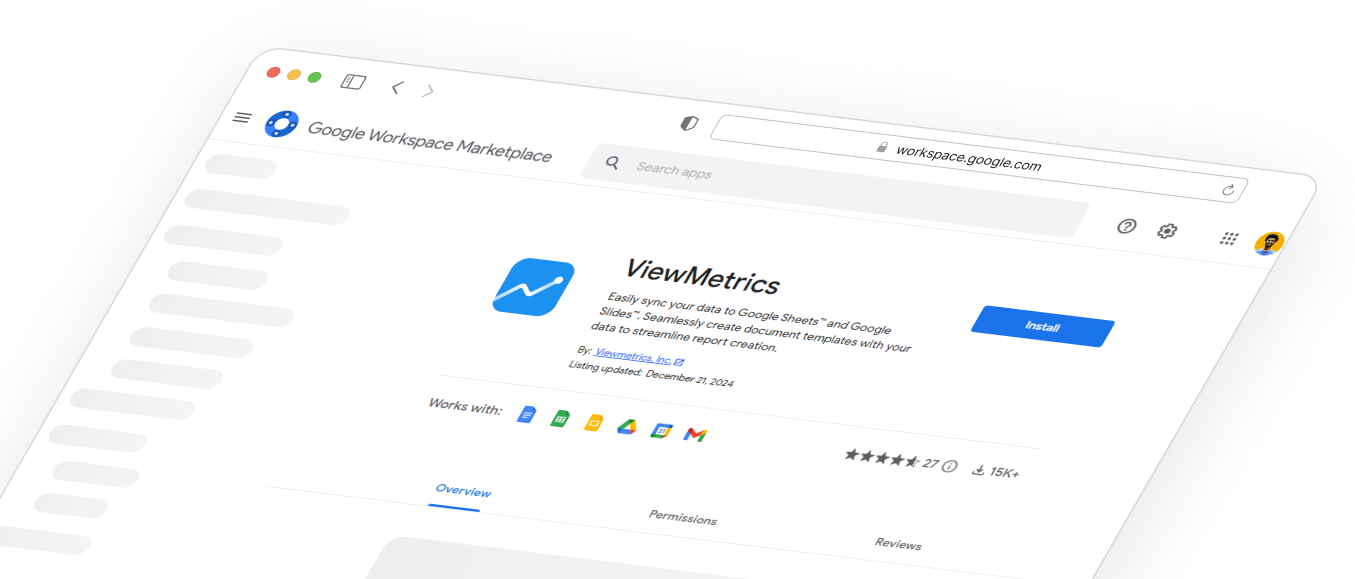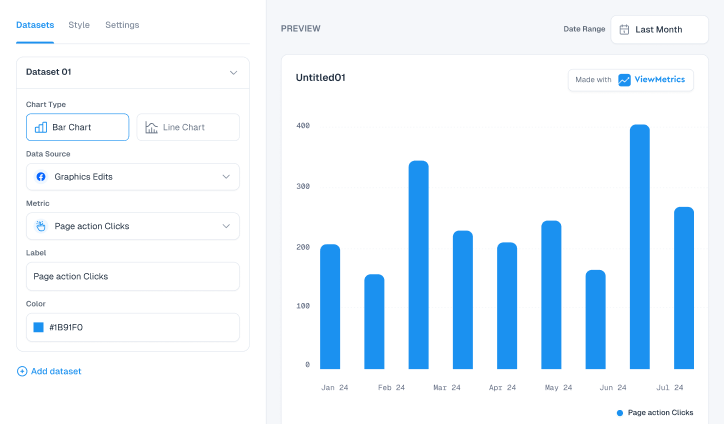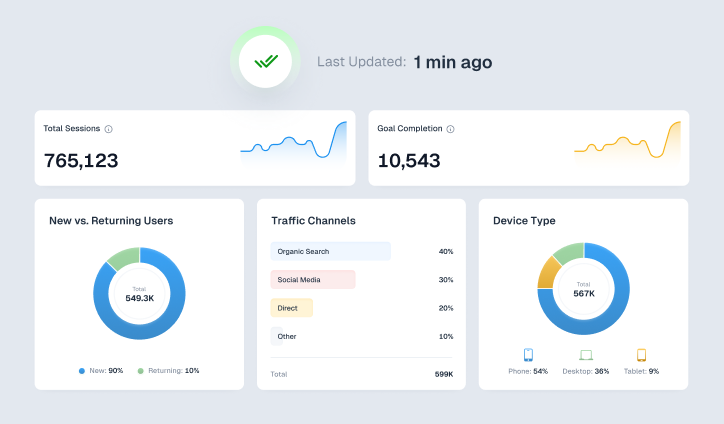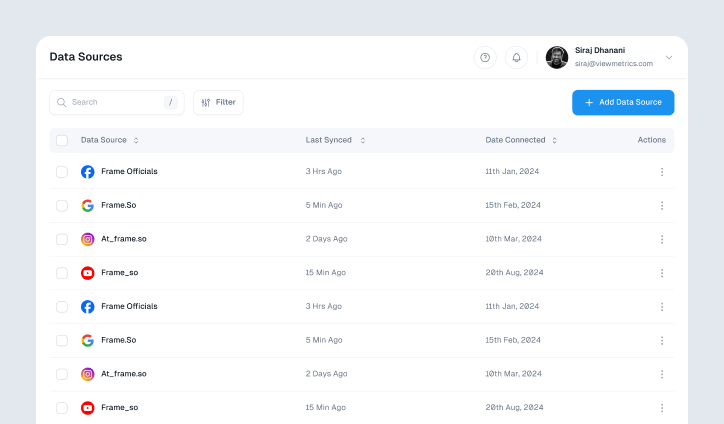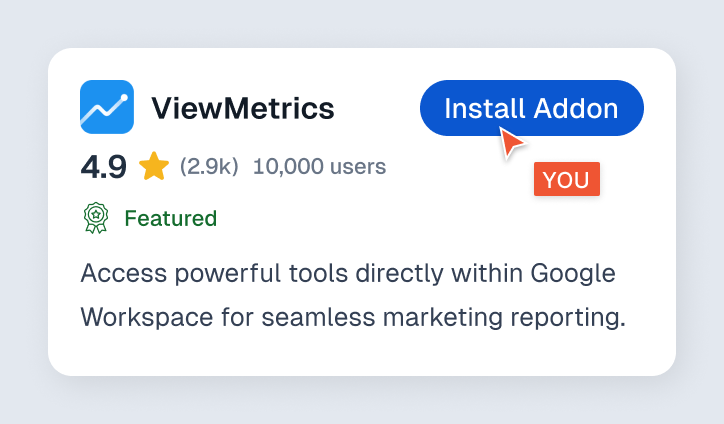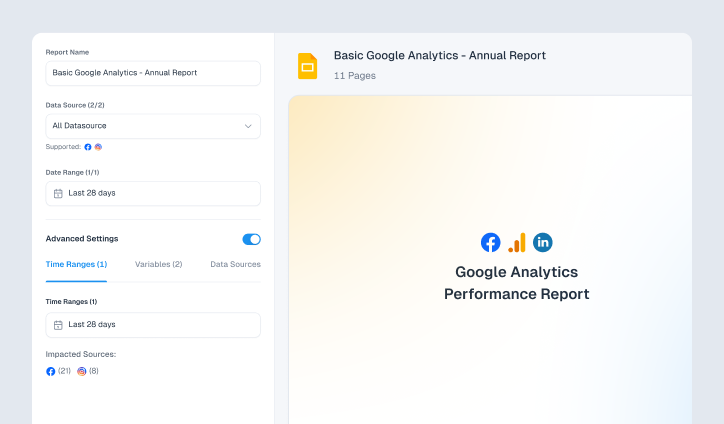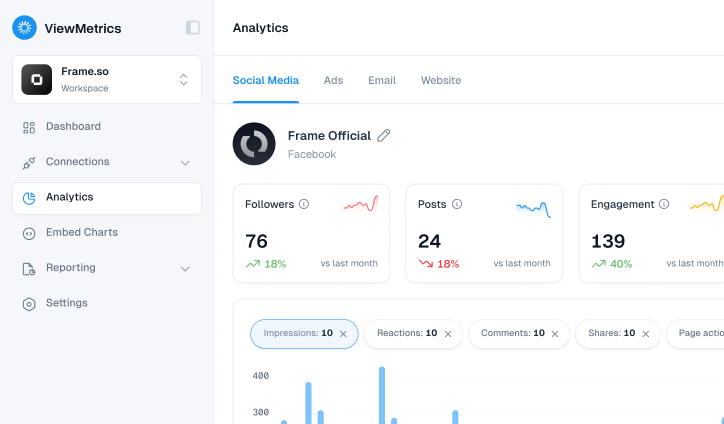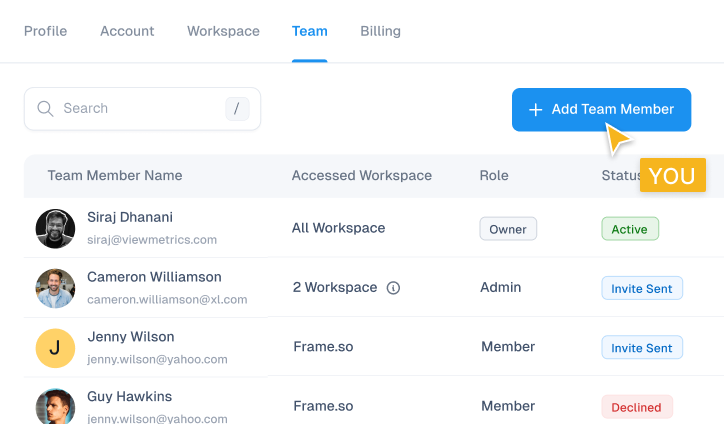Summary for the Blog
- QBR stands for Quarterly Business Review, a meeting between a business and its Customer Success Manager (CSM) to review progress, goals, and milestones from the previous quarter.
- The primary goal of a QBR is to demonstrate value to the client, build strong relationships, and identify opportunities for renewals or upsells.
- Key benefits of a QBR include keeping all parties in sync, evaluating performance against goals, and strengthening client relationships.
- An effective QBR agenda should include an executive summary, business ROI, benchmarking data, and a clear plan for future steps.
Running Quarterly Business Reviews (QBRs) that focus on your customers while also driving product growth can be challenging. But don’t worry—we’ve got you covered with the key strategies and tips to help you craft your own. In this guide, we’ll break down the most important elements of an effective QBR and share practical insights to ensure yours not only meets expectations but also propels your business forward.
What is QBR?
QBR, or Quarterly Business Review, is a call or meeting that is done quarterly between the stakeholders and the CSM (Customer Success Manager) of a business to review the milestones and goals that have been accomplished in the previous quarter based on the success plan built between the customer and the CSM.
It is a rare occasion where the CSM can engage directly with most, if not all, of the customer’s key stakeholders. This gathering gives the CSM a prime opportunity to reinforce their role as a trusted strategic advisor and showcase the real value they’ve brought to the table, especially by underscoring the positive results they’ve helped drive.
How Does QBR Benefit Your Business?
Quarterly business reviews are known to benefit both your business and your clients. There are several reasons why this is a valid point. Let’s see how QBR is advantageous to your business:

1. Keeps You in Sync
A key advantage of quarterly business reviews is the way they keep you and your clients aligned. Often, you’re working together on projects, each side bringing something to the table. With this collaboration, staying in sync is essential to ensure the work flows smoothly and meets shared goals.
For instance, you’re providing graphic design services. Regular QBRs are a form of check-in to confirm that both you and your clients are clear on the style preferences, design direction, and objectives you’re aiming to achieve. This way, there’s no guesswork, and you’re both confidently moving toward the same vision.
2. Evaluates Your Performance
Quarterly business reviews offer another valuable benefit: they let you assess how effectively you’re meeting your clients’ needs. Since you’re providing a service, clients naturally expect to see concrete results. If there are any concerns, it’s far better to catch them early, and QBRs are a perfect setting for that.
These reviews give you the chance to celebrate your wins and gauge client satisfaction, ensuring you’re always tuned into their expectations and making any adjustments needed to keep things on track.
Data tracking plays an important role in evaluating your performance.
3. Engages Your Clients
Regular quarterly check-ins with your clients are essential for keeping them engaged and satisfied. Without consistent communication, clients may feel out of the loop and start questioning the value of your partnership. Not only this, but quarterly business reviews allow you to regularly showcase the impact you’re making for their company, reinforcing the value of your work. This proactive engagement reassures clients and strengthens their commitment to a long-term partnership with you.
4. Carves Deeper Bonds
With regular QBR meetings, you can deepen your bond between your as well as your customer’s executives. Quarterly business review meetings help create a strong communication bridge between the client and the company, which fosters a deeper understanding of requirements that can turn into successful work value.
5. Gets Renewal Opportunities
Gaining a deeper understanding of your client’s business goals and priorities while building a strong, trust-based relationship opens doors to mutually beneficial growth. Quarterly business reviews are perfect for exploring potential upsells that align with your client’s needs, adding value to their experience. They’re also a good time to mention any upcoming renewals. For long-term clients, you might even suggest a multi-year agreement at a discounted rate, making it easier for them to commit while rewarding their loyalty.
6. Showcases Value
When all key stakeholders are present in the meeting, it’s the ideal moment to showcase the milestones achieved with your solution, especially those accomplished with valuable guidance and insights from your Customer Success Manager. This setting lets you highlight tangible successes and reinforce the CSM’s role in driving results.
A marketing dashboard can help you showcase the value you provide through the end results.
7. Provides Strategic Planning
In the BPO industry, strategic planning is crucial. Business reviews offer a structured way to align your services with your client’s long-term vision. By diving into their goals, challenges, and key industry trends, you can collaboratively shape a roadmap for success. This approach not only elevates the client experience but also keeps your business closely attuned to their evolving needs. Strategic planning through these reviews ensures your services stay both relevant and impactful.
View All Your Marketing and Website Data — Instantly
Connect Instagram, Mailchimp, Google Analytics & more
Pre-built dashboards, no setup needed
Save hours on reporting every week
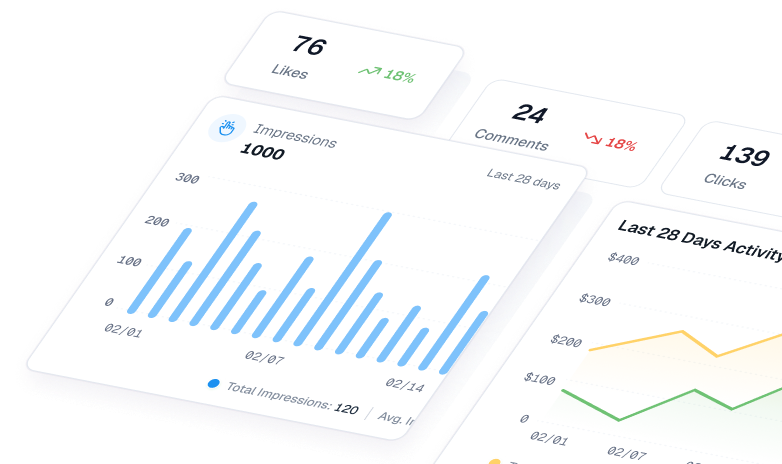
Things to List in Your QBR Agenda
Now you know the importance of having regular QBR, it’s time to understand all the agendas to include in these meetings for successful collaboration. Below is a list of things to include in your QBR agenda:

1. Executive Summary
An executive summary is the first thing to include in your QBR agenda. This is the part and your best opportunity to include all the essentials. Here’s where you will celebrate everything you achieved in the previous quarter and also mention everything that you weren’t able to achieve in the quarter so that your clients know what to expect from the report.
2. Business ROI
QBRs give you the perfect platform to spotlight the return on investment (ROI) your product has brought to your customer’s table. Making ROI the focal point of these discussions allows you to show, in clear terms, how your solution is delivering value. Review what’s been achieved, update timelines as needed to align with any new insights or goals they’ve shared, and explore potential new directions based on your shared progress so far.
Make sure this part of the conversation feels highly relevant to that specific customer. Focus on the goals they’ve prioritized and what’s possible for them based on how they’re using your product.
Related Read: What is Cost Per Lead?
3. Benchmarking Data
Companies are always interested in knowing where they stand against their competitors, and if you can link that success to your product with solid metrics, they’ll be more inclined to keep working with you. Pay close attention to what catches their interest, the questions they raise, and the specific metrics they focus on. This insight is valuable for nurturing the relationship and equipping your sales and marketing teams with the information they need to drive expansions and upsells later.
4. Customer Feedback Analysis
Customer feedback offers valuable insights into a customer’s needs and priorities. If you’ve gathered feedback ahead of time, the review is a chance to address any open topics or questions. Additionally, QBRs are a prime opportunity to gather fresh feedback. Use this time to hear directly from your customer about their experiences, perspectives, and concerns. Post-meeting, you can leverage these insights to plan actionable next steps that strengthen the customer relationship and elevate their overall experience.
You can use various data analytics tools to analyze customer feedback.
5. New Service/Product Updates
A quarterly business review is the perfect chance for you to update your customers about your new products or services. Whether it is an entirely new product/service or an update to an older version, this is your chance to let your customer base know you are bringing something new, and they might even find something that would interest them.
6. Upsells and Renewals
Once you’ve laid the groundwork for renewals and upsells by showcasing ROI and benchmarking, this is the moment to take action and push for those opportunities. Whether it’s discussing contract renewals, introducing premium packages or services, or exploring other strategies that will strengthen your long-term partnership, this is the time to move the conversation toward securing the future of your relationship.
7. Next Steps and Strategies
The quarterly business review process doesn’t end when the meeting wraps up. After the discussion, CSMs can take the insights and feedback to plan for the future. This might involve setting new action steps, refining goals and objectives, or adjusting strategies to align with what was covered during the meeting. The follow-up is just as crucial in ensuring continued progress and success.
9 Best Practices for Conducting the Quarterly Business Review
Once you have listed your QBR agenda, it’s time to follow the best practices for conducting your quarterly business review. Here are some of these practices for your next QBR to maximize your business outcomes:

1. Call the Right People
Make sure your QBR team invites the key executives from both your company and your clients. This ensures you’re engaging with the right stakeholders, including decision-makers who hold the power to renew the contract.
2. Prepare Nicely
A strong CSM will come to the meeting well-prepared, having proactively identified and resolved potential concerns ahead of time. By anticipating challenges and tackling them before the meeting, you can ensure a smooth and productive QBR. This level of preparation helps avoid any surprises that could disrupt the meeting or harm the relationship.
You must use a marketing report to present your efforts in the meeting.
3. Adopt a Customer-Focused Mindset
When preparing for your QBR, make sure to center it around what matters most to your customer. Rather than listing all your work or detailing every achievement, focus on how those efforts directly benefit them.
4. Show Benchmarking Data Through Visuals
Comparing your results with industry data and statistics can make a huge impact. Why? Customers love to see how they stack up against the industry and their competitors. By presenting solid metrics, you can clearly highlight how your product has contributed to their success, especially when compared to others in the market. Pay attention to the numbers that stand out to your customers and focus on the metrics that matter most to them. This approach clarifies your value and motivates customers to continue their partnership with you.
Useful Read: What is Data Interpretation?
5. Hold the QBR Meeting in Person
When it comes to QBR meetings, face-to-face interaction is key. Whether you’re meeting in person or connecting through a video call, being able to see your customer allows for a more engaging experience. It lets you present visual data and have a dynamic conversation. A simple phone call just doesn’t offer the same level of connection or impact.
6. Get a Moderator
It may seem like a simple step, but appointing a moderator is crucial for ensuring your QBR runs smoothly and achieves its goals. Having a senior leader, such as the VP of Customer Success, a senior CSM, or a product head, take the reins sets the tone for the meeting. This person will not only guide the conversation but also prepare the agenda to ensure they’re familiar with every topic. The moderator’s role is to keep the discussion on track, present the agenda effectively, and handle all the behind-the-scenes tasks that make the meeting seamless.
7. Be Transparent
The goal of a QBR is to build trust and deepen your relationship with the customer. That’s why it’s important to be upfront about both the successes and the shortcomings of your product. Acknowledge where things haven’t gone as planned, and share the steps you’re taking to improve. This level of honesty shows your customer that you’re committed to their success and willing to put in the effort to help them achieve their goals.
8. Keep the QBR Short
A successful QBR should be concise and to the point. Aim to keep it under an hour—anything longer risks losing your customer’s attention. Stick to what matters most, and avoid unnecessary discussions or activities that could drag the meeting out. Respecting your customer’s time will leave a lasting, positive impression.
9. Schedule the Next QBR
Before wrapping up, make sure to schedule your next QBR with the customer. This is also a great time to set clear goals for the upcoming quarter. You can introduce new opportunities for growth, product updates, or add-ons that can help them meet their objectives. Be sure to outline who will take responsibility for each goal and the tasks that come with it, ensuring everyone knows what’s expected moving forward.
Why Reports are Important for QBR?
Reports are essential for a successful Quarterly Business Review (QBR). They give you a clear snapshot of how your business is performing, guiding decisions and highlighting areas where you can improve. Here’s why reports are so crucial for QBRs:
- Informed Decision Making: Reports are packed with valuable data that reveal patterns, opportunities, and challenges. Relying on this information ensures you’re making decisions backed by facts, reducing risks, and increasing the likelihood of success.
- Boosting Accountability: When team performance is tracked and measured, it encourages everyone to stay focused and committed to their goals. Knowing their work is being monitored can inspire greater effort and responsibility.
- Clear Communication: Reports act as a shared reference point for discussing business performance. Using consistent data and metrics ensures everyone is aligned, avoiding any confusion or miscommunication.
- Spotting Issues Early: Regular reports make it easier to spot potential problems early on before they snowball into bigger issues. Proactively addressing these concerns saves time, money, and resources down the line.
- Better Customer Experience: Reports allow you to measure customer satisfaction and pinpoint areas that need improvement. By focusing on delivering a top-notch customer experience, you can foster stronger relationships and encourage repeat business.
In short, reports are more than just numbers—they’re a roadmap for growth, accountability, and success.
How Does ViewMetrics Help to Create Effective QBR Reports?
As you have seen already, QBR reports are necessary for the growth of a business. From making informed decisions to making better customer experience, these reports are crucial for streamlining your business success. But making these reports can be a tedious process, especially when you already have a lot of things on your plate.
ViewMetrics streamlines your process of making QBR reports by automating it. All you need to do is connect your data sources using our automated tool! Pick any desired report template, and you will be all set to create effective QBR reports.
View All Your Marketing and Website Data — Instantly
Connect Instagram, Mailchimp, Google Analytics & more
Pre-built dashboards, no setup needed
Save hours on reporting every week
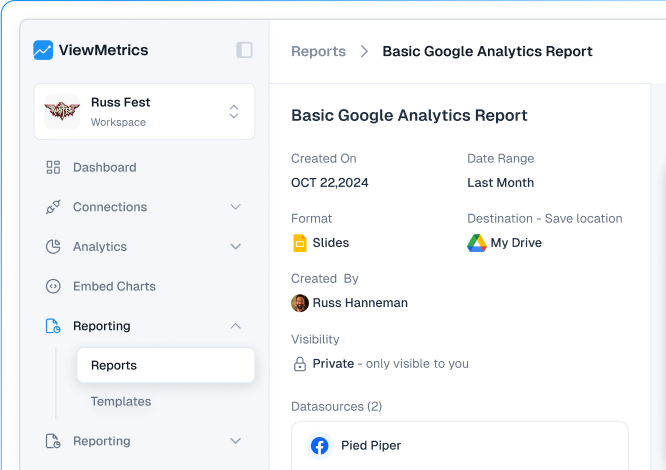
Frequently Asked Questions
Who should be part of a QBR?
When it comes to the customer side, the ideal attendees are executive sponsors and key decision-makers. While it’s not a must, inviting other department heads who engage with your product or its outcomes in any way can be incredibly helpful. This ensures that everyone who plays a role in the product’s success is on the same page and can contribute valuable insights.
How can QBRs work well for remote teams?
For remote teams, QBRs can be highly effective by leveraging video conferencing tools, choosing meeting times that accommodate different time zones, and ensuring open, clear communication channels. This approach keeps everyone connected, engaged, and aligned, even when they’re working from different locations.
What’s the best way to follow up after a QBR?
Following up after a QBR is crucial. The best approach is to summarize the main takeaways clearly, outline the next steps, and list action items with assigned responsibilities and timelines for follow-up. This ensures everyone knows what’s expected and keeps the momentum going.




